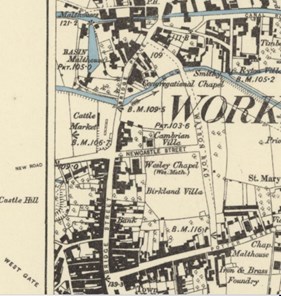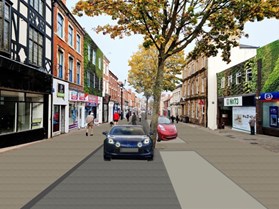When creating the Worksop Masterplan, we brought in the expert services of Planning and Development Consultant Timothy Crawshaw. In the sixth of a series of Blogs, he charts the history of Bridge Street and how we can make the river and other historic elements a catalyst for change.
Last time we considered the future of the Town Centre as a great place to live and the role of Bridge Street to provide additional accommodation. In this blog we can expand on what Bridge Street has to offer and how this fits into the Masterplan.
The Ordnance Survey map of 1886 shows how the Town Centre was laid out as well as how this finely structured high street gently curves down to the River Ryton and the Chesterfield Canal. In this map there is a clear gap where Bridge Street crossed the river. However, the bridge that gave its name to the street is now lost, with only a hint of the water below picked out in the paving under the feet of shoppers and visitors.

To the south, the historic burgage plots can be clearly seen and the yards and lanes created as these plots were built out are still in evidence today. To the west of Bridge Street these are more evident than to the east, although closer observation reveals these historic routes. These yards have a distinctive and intimate feel and ongoing projects such as the Middletons Business Hub demonstrates the potential for these areas to the rear of Bridge Street to come to life, accommodating a wide range of uses.
Bridge Street, as an important route from north to south, is crossed by Newcastle Street that connects the site of Worksop Castle to the former Priory and Priory Church. At the crossing of these two routes are fine buildings that demonstrate the importance of Worksop as wealth was created from the mining industry and the presence of the Chesterfield Canal.
The Masterplan seeks to celebrate the multi-layered history of Worksop, using improved walking and cycling connectivity to better reveal the assets and add to the offer of the town. Whilst retail will remain the focus of Bridge Street, there may be scope to accommodate other uses as shopping patterns change.
The urban structure and the historic assets are important. Their protection is essential if their use in the future is to be secured, possibly with a resurgence in retail as the Town Centre is re-established as a place to live and work and once again be the heart of the community.
Where there are unsympathetic modern buildings, the Masterplan proposes that these are transformed through the use of green walls to provide a contrast and setting for the historic buildings, whilst also extending the potential for habitats and ecology.
The consultation also asks for views on the future of Bridge Street in terms of vehicular access and the better management of cycling. The image below shows the potential for cars to come back onto Bridge Street as well as green walls to improve the character of the street, alongside additional tree planting.

Next time we will explore the future of the former Market Place and its role in the future of the town, reimagined as a family friendly public space and once again a centre for markets.
For more information about the history of Worksop, the Heritage Trail provides an interesting insight into the development of the town. The Bridge Street Project has also captured many memories.
- Worksop Heritage Trail - Should you wish to view this leaflet, please contact our customer services team to request a copy.
- Bridge Street Project - The Photo Archive
Timothy Crawshaw (MA MRTPI FRSA) is an International Planning and Development Consultant in the areas of urban design, planning, green infrastructure, energy efficiency and sustainable transport.
With experience in Eastern Europe, Africa and the Middle East, alongside an expanding UK practice, he has a specific interest in the role of the nature based approaches to addressing the climate emergency, alongside improving health and wellbeing outcomes and tackling inequality.
Timothy is an experienced lecturer, trainer and facilitator with a passion for community development, and he continues to champion the role of planning as a key part of the solution to the challenges of our times. Timothy is currently the Chair of the Tees Valley Nature Partnership and of the Historic Towns and Villages Forum and will be the Vice President of the Royal Town Planning Institute in 2021.
Last Updated on Wednesday, May 8, 2024